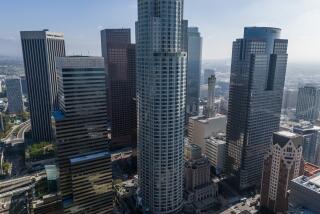Cell Phone Antenna Towers Raise City Concerns
- Share via
With cellular phone antenna towers sprouting in Los Angeles neighborhoods at the rate of two or three per week, city officials are struggling to manage the proliferation and make sure those that are erected are not eyesores.
New and tougher rules drafted by the city would require special permits for more of the antennas and would set minimum standards for their proximity to residences.
The ordinance being considered by the City Council also requires poles and rooftop antennas to be camouflaged with paint, screens or landscaping and includes measures aimed at forcing companies to cluster their antennas together on one pole as much as possible.
“The controls now in place are simply inadequate to protect our neighborhoods from being overwhelmed by cell phone antennas, and they do not have the force of law,” said Councilwoman Cindy Miscikowski, who serves on the committee recommending the changes.
City planners estimate Los Angeles has about 1,000 antenna sites and that the city receives 100 to 200 applications for new antennas each year.
Kathy Delle Donne, a member of the Tarzana Property Owners Assn., said she went to a planning hearing Friday in the San Fernando Valley at which eight applications for new antennas were considered.
A new ordinance is long overdue, she said.
Growing Demand for Wireless Phones Cited
Industry officials, who oppose the city’s proposed changes, say there is a legitimate need to provide antenna towers to serve the growing demand for wireless phones and pagers.
Kevin Tamaki, a Pacific Bell spokesman, said there is no need to adopt an ordinance that codifies and expands current guidelines because companies are already being responsible in placing and disguising the antennas.
“We disagreed with the committee. Things have worked very well with the current process,” Tamaki said.
Industry officials say the state of the art allows antenna towers to be disguised as pine or palm trees so that many people are not even aware of them.
“If you stare at it long enough, you can tell it’s not a real tree,” said Daniel Green, an associate zoning administrator for the city. “But if you drive by at 50 mph, you won’t notice it.”
Councilman Hal Bernson, who chairs the planning committee, agrees the industry often does a good job of camouflaging the poles. He said the city must let the industry serve its customers, but he said too often multiple towers have gone up in close proximity to one another when the antennas could have been clustered together on one camouflaged pole or rooftop.
That concern is weighing heavily on the residents along a stretch of Yarmouth Avenue in Northridge.
City officials are considering an application that would allow Pacific Bell to build a 65-foot antenna tower disguised as a palm tree, adjacent to an existing 55-foot tower, also built to look like a palm tree, according to Debbie Dyner, an aide to Councilwoman Laura Chick.
“What are we creating here?” Dyner asked. “Are we creating a forest?”
City planners cannot consider health questions when deciding whether to approve an antenna tower because that area is under the jurisdiction of the federal government.
“We can only consider aesthetics,” Green said.
Three years ago the city adopted general guidelines that called for antenna towers to be camouflaged and landscaped as much as possible, but Councilwoman Miscikowski said planners have broad discretion to interpret and follow the guidelines because they have not been adopted as requirements in the city municipal code.
As a result, some antennas are built to blend in and not be a visual blight, and others are not, Miscikowski said.
So council members are recommending existing guidelines be provided in more detail and put into the city municipal code through adoption of an ordinance mandating that the rules be followed.
The proposed ordinance also expands and toughens requirements.
For instance, cell phone antennas can now be built in industrial zones without a permit. Under the new ordinance, the wireless companies would have to get a conditional use permit if the proposed tower is for an industrial zone but next to homes.
The new ordinance would also set a minimum distance from residences, equal to 20% of the height of the antenna.
Additional landscaping requirements would be set and screening required so that no more than 25% of the tower and antenna be visible from adjoining properties.
But Miscikowski said perhaps the most important change would require cell phone companies to provide a list of all their other towers and antennas when applying for a new site.
With all companies providing the city with a database on the location of existing towers, officials say city planners would have more leverage to get companies to co-locate new antennas on existing poles, even if the poles are owned by competitors.
The ordinance also would require poles to be designed so other antennas could be added.
The goal, according to Chick, is fewer sites.
Official Says Uniform Standards Are Needed
Officials from half a dozen companies testified against adopting an ordinance to regulate the antennas, noting the city Planning Commission recommended against adding the rules to the municipal code.
Tamaki said the city can more quickly change guidelines than it can adopt an ordinance to amend the municipal code.
“We appreciate having flexibility because the technology changes so rapidly,” Tamaki said.
But Miscikowski said the proliferation of antenna towers requires the adoption of enforceable, uniform standards.
“Once the City Council approves this ordinance, Los Angeles will have a law with teeth, and not just a series of inadequate, outdated guidelines,” Miscikowski said, adding she hopes to bring the proposed ordinance before the full council by late June.
More to Read
Sign up for Essential California
The most important California stories and recommendations in your inbox every morning.
You may occasionally receive promotional content from the Los Angeles Times.














